Re-discovered species of Camellia krempfii (Gagnep.) Sealy in Vietnam: a critique of Luong Van Duong, Truong Quang Cuong, Pham Huu Nhan, Le Nguyet Hai Ninh article, pp.139-141, International Camellia Society Journal (ICSJ) 2014, Journal Number 46
Anthony S. Curry
Monsieur Krempf made the original collection from the ‘Ton-ha foothills near Nha Trang’ (no. 1,564) in 1912 but it was not until March 1942 that Francois Gagnepain first described and published the taxon, Thea krempfii, in Notulæ Systematicæ x., fascicle 3, p. 127-128. In 1958 John Robert Sealy re-named it, Camellia krempfii (Gagnep.) Sealy, in his benchmark work, ‘A Revision of Genus Camellia’.
Luong et al in their article, ‘Re-discovered species of Camellia krempfii (Gagnep.) Sealy in Vietnam’, claimed that plant material collected from Hon Giao in Lam Dong and Khanh Hoa Provinces was that of Camellia krempfii (Gagnep.) Sealy. The authors also claimed that their specimen was the first re-collection of C. krempfii since Krempf’s original collection in 1912. Both of these claims could only be substantiated after thorough analysis of the morphology of the samples collected and a comparison of these with the type specimen and its descriptor.
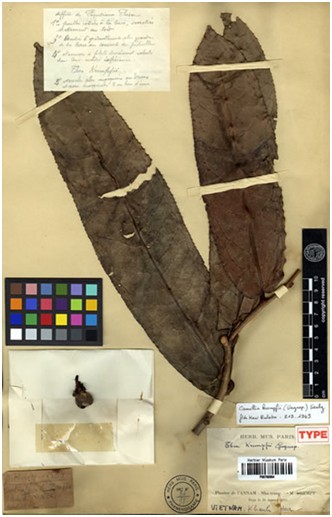
Image 1. Image of the type specimen of Thea krempfii (syn. C. krempfii) from the National Museum of Natural History, Paris, France
In November 2013 a member of the original collection team invited Dr Orel and me to inspect the Hon Giao site and collect some flowering material of the Camellia species in question for diagnosis and confirmation of their identification. A methodical documentation of the Hon Giao material was completed and specimens were prepared for pressing and drying. A cursory inspection of this material suggested that this plant was not C. krempfii (Gagnep.) Sealy. Following our return to Australia a literature review was completed and an exhaustive examination of the pressed specimens and field notes was undertaken.
After a comprehensive analysis of an image of the type specimen of Thea krempfii Gagnep. (syn. C. krempfii (Gagnep.) Sealy (Image 1)); its descriptor in Gagnepain 1942, pp.127-128; Sealy, 1958, pp.36-38 and the Camellia described in the article by Luong et al, ICSJ, 46, pp.139-141 from Hon Giao it was apparent that the morphological features of the two Camellia species did not correlate (Refer to Table 1 for details).
|
Morphological Feature |
Thea krempfii Gagnepain (1942) |
Sealy (1958) |
‘C. krempfii’ (material collected from Hon Giao: Luong et al 2014) |
C. hongiaoensis Orel & Curry (2014)
|
|
Petiole length (cm) |
0.8 |
1.5 |
1-1.5 |
2–3 (–3.5) |
|
Leaf size (cm) |
|
28.5-31 x 6-7.5 |
25-35 long x 6-9 |
35–41 x 9.5–10.5 |
|
Leaf venation |
Reticulate veins more visible above |
Impressed above, raised below |
Raised and clearly visible below |
Adaxially sunken, abaxially slightly prominent |
|
Pairs of lateral veins |
12 |
About 20 |
20-24 |
20–23 |
|
Flower colour |
White? |
White? |
Dark pink |
Coral pink to dark pink (petal & sepal margins white) |
|
Calyx (Sepals) |
7-8 |
Bracts & sepals 15 |
5 (persistent) |
3-5 (perules)
|
|
Petal number |
|
About 10 |
12-16 |
7-10 |
|
Petal size (cm) |
|
1.7-3.5 long x 1.4-2.6 wide |
2 x 1.7 (outside) to 3.3 x 3.5-4 (inside) |
3.5–4.5 long x 3.5–4.5 wide |
|
Stamen fusion |
Connate at base |
United with corolla for 1-2 mm; outer stamens connate for 7-8 mm above union with corolla to form a fleshy cup |
Adnate with petals and connate for about 1.5 cm from base; inner filaments (3 circles) joined for only 3 mm from base |
Outer filaments connate for about 5 mm, inner filaments free |
|
Stamen hairiness |
Villous (long, soft hairs) below middle of the filament |
Outer filaments puberulous-velutinous in lower half or lower 7-8 mm of inner filaments |
Hairy |
Glabrous |
|
Style length (cm) |
1.5 |
*1.5 |
3 |
3.5–4 |
Table 1. A comparison of the morphological features of Thea krempfii Gagnepain (1942), Camellia krempfii (Gagnep.) Sealy, C. krempfii material collected from Hon Giao by Luong et al 2014 (Luong et al 2014) and C. hongiaoensis Orel & Curry (2014)
From Table 1. it was evident that the major divergences in morphology related to: petiole length (Thea krempfii Gagnepain [0.8-(1.5 Sealy) cm], the Hon Giao material of Luong et al [1.5cm] and Orel & Curry [2-3.5cm]); leaf size (C. krempfii Sealy [28.5-31 x 6-7.5 cm], the Hon Giao material of Luong et al [25-35 long x 6-9 cm] and Orel & Curry [35–41 x 9.5–10.5 cm]); the number of pairs secondary veins (T. krempfii [12], C. krempfii Sealy [about 20], the Hon Giao material of Luong et al [20-24] and Orel & Curry [20-23]); flower colour (T. krempfii [white?], C. krempfii Sealy [white?], the Hon Giao material of Luong et al [dark pink] and Orel & Curry [Coral pink to dark pink with petal & sepal margins white, i.e. a bicoloured flower]); number of petals (C. krempfii Sealy [about 10], the Hon Giao material of Luong et al [12-16] and Orel & Curry [7-10]); size of petals (C. krempfii Sealy [1.7-3.5cm long x 1.4-2.6cm wide], the Hon Giao material of Luong et al [2-3.3cm long x 1.7-4cm wide] and Orel & Curry [3.5–4.5 cm long x 3.5–4.5 cm wide]); stamen hairiness (T. krempfii [villous (long, soft hairs) below middle of the filaments], C. krempfii Sealy [outer filaments puberulous-velutinous in lower half or the lower 7-8 mm of the inner filaments], the Hon Giao material of Luong et al [hairy] and Orel & Curry [glabrous]) and the length of the styles
(T. krempfii [1.5 cm], C. krempfii Sealy [1.5 cm], the Hon Giao material of Luong et al [3 cm] and Orel & Curry [3.5-4 cm]).
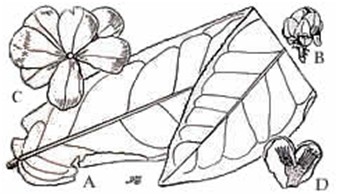
Image 2. Line drawing of C. krempfii: A, leaf; B, flower-bud; C, corolla, adaxial view; D, two petals and part of androecium, inner surface ex JR Sealy from Krempf 1,564 (Sealy, p.37)
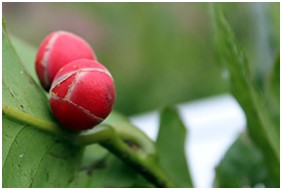
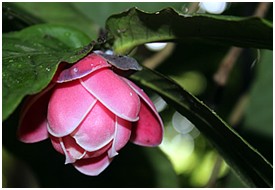
Image 3. C. hongiaoensis flower buds Image 4. Opening flower bud of C. hongiaoensis
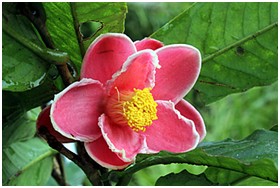
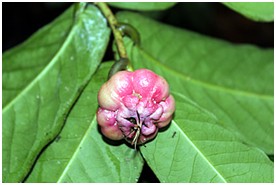
Image 5. Flower of C. hongiaoensis Image 6. Developing fruit of C. hongiaoensis
Images 3-6: C. hongiaoensis from a field trip to Bidoup-Nui Ba National Park and Hon Giao in August, 2014
|
Morphological Feature |
Thea krempfii Gagnepain (1942) |
Difference or Percentage variation of ‘C. krempfii’ material collected from Hon Giao by Luong et al (2012) (%) |
Difference or Percentage variation of C. hongiaoensis Orel & Curry (2014) (%) |
|
Petiole length |
0.8 cm |
125-187 |
250-375 (-437) |
|
Leaf size |
[S]28.5-31 cm long x 6-7.5 cm wide |
87-113 x 100-120 |
123-132 x 140-158 |
|
Number of pairs of secondary veins |
12 |
166-200 |
166-191 |
|
Flower colour |
White? |
Dark pink |
Coral pink to dark pink with white petal & sepal margins |
|
Sepal number |
7-8 |
62-71 |
37-43 to 62-71 |
|
Petal number |
[S]About 10 |
120-160 |
70-100 |
|
Petal size |
1.7-3.5 cm long x 1.4-2.6 cm wide |
94-117 x 121-153-250 |
128-206 x 173-250 |
|
Stamen Fusion |
Connate at base |
Adnate with petals and connate for about 1.5 cm from base; inner filaments (3 circles) joined for only 3 mm from base |
Outer filaments connate for about 5 mm, inner filaments free |
|
Stamen hairiness |
Villous (long, soft hairs) below middle of the filament |
Hairy |
Glabrous |
|
Style length |
1.5 cm |
200 |
230–266
|
[S] from Sealy(1958)
Table 2. A comparison of selected morphological features of Thea krempfii Gagnep., ‘Camellia krempfii’
material collected from Hon Giao by Luong et al 2014 and Camellia hongiaoensis Orel & Curry (2014)
Scrutiny of the data in Table 2 revealed that on average: the length of the leaf stalks (petioles) of the Hon Giao material was about 275% longer than those of Thea krempfii Gagnepain or Camellia krempfii (Gagnepain) Sealy (T. or C. krempfii); the leaf size Hon Giao material was 206% longer and 130% wider than T. or C. krempfii; there are 180% more pairs of lateral veins on the Hon Giao material compared with C. krempfii; the flower colour of T. or C. krempfii is white (?) while that of the Hon Giao material was coral pink-dark pink; T. or C. krempfii has 225% more sepals than the Hon Giao material; the number of petals on the Hon Giao material was 112% more than that of T. or C. krempfii; the petals of the Hon Giao material were 104% longer than the T. or C. krempfii and the petals of the Hon Giao material were up to 189% wider than those of T. or C. krempfii; the stamens of T. or C. krempfii were villous from the base up to half the length of the filaments, while the stamens of Hon Giao material were either hairy or glabrous and the style lengths of the Hon Giao material were 232% longer than T. or C. krempfii.
The analysis of the specimens from Hon Giao confirmed our initial suspicion that the Camellia plant material from the Hon Giao site was not C. krempfii as suggested by Luong et al (2014).
Conclusion
The Hon Giao Camellia material collected by Luong et al therefore was not a re-discovery of Krempf’s Camellia as purported in the popular media in Vietnam but a species new to science as it possessed sufficient morphological differences to justify its classification as such.
The new species was named, C. hongiaoensis which referred to the Hon Giao geographical area in the Province of Khanh Hoa in Vietnam where the species was collected. Full documentation of C. hongiaoensis may be found in the paper: ‘A new species of Camellia Section Dalatia (Theaceae) from Vietnam’ Orel and Curry) in Telopea, Journal of Plant Systematics, The Royal Botanic Gardens & Domain Trust, Volume 17: 99–105 (Publication date: 16 July 2014). This paper uses the citation Camellia krempfii non auct. (Gagnep.) Sealy to reference the misidentification of the Hon Giao material, as C. krempfii (Gagnep.) Sealy, referred to in the popular Vietnamese press and websites at the time of collection. For more information concerning our determination or for further clarification please refer to the article in ‘Telopea’ online: http://openjournals.library.usyd.edu.au/index.php/TEL/article/view/7551/7976.
References
Chang, H.T. & Bartholomew, B. (1984). Camellias. Timber Press, Portland, Oregon.
Gagnepain, F. (1941). Notulæ Systematicæ x., Fascicle 3, p. 127-128, March 1942
Luong, V. D, Truong, Q. C, Pham, H. N. & Le, N. H. N. (2014). International Camellia Society Journal, Journal Number 46, pp.139-141
Orel, G. & Curry, A.S. (16 July 2014). TELOPEA, Journal of Plant Systematics, Volume 17: 99–105. A new species of Camellia Section Dalatia (Theaceae) from Vietnam. http://openjournals.library.usyd.edu.au/index.php/TEL/article/view/7551/7976
Sealy, J.R. (1958). A revision of the genus Camellia. The Royal Horticultural Society, London.
Supplementary Resources
http://tuoitrenews.vn/society/14711/krempf-flower-found-in-vietnam-after-one-century
http://bidoupnuiba.gov.vn/index.php?option=com_content&view=article&id=376%3Aphat-hin-mt-qun-th-tra-hoa-krempf-camellia-krempfii-ti-khu-vc-hon-giao&catid=71%3Att-nghien-cu-rn-quc-t&Itemid=106&lang=en
http://www.talkvietnam.com/2014/05/almost-extinct-vietnam-flower-breed-conserved/
http://laodong.com.vn/van-hoa/khanh-hoa-bao-ton-tra-hoa-krempf-213624.bld
Web design by Tribal Systems
